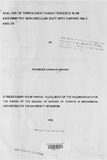Analysis of turbulence characteristics in an axisymmetric non-circular duct with varying half angles

View/
Date
1996Author
Kibicho, Perminus Karanja
Type
ThesisLanguage
enMetadata
Show full item recordAbstract
Investigated in this work are the various turbulence characteristics in a non-circular axisymmetricduct of varying half angles.
The turbulence was measured using constant temperature hot-wire anemometry. The voltage signals were linearized through a Kanomax linearizer. The data acquisition was done through an analog to digital converter compatible with the IEEE-488 interface bus which recorded data direct into a NEC personal computer using a software KIBICHO.BASdeveloped by the author.
Four different half angles were investigated,that is, 10°, 15°, 17.5° and 20°.
For each half angle, four different planes at distances 0, 100, 200 and 300 mm from the duct's exit plane were investigated. The diverging section of the duct was of length 600 mm.The experimental nodes were in a mesh of 10 x 10 mm.
Preliminary results showed that the turbulence characteristics were independent of the Reynolds number and hence all the experiments were carried out at a constant Reynolds number corresponding to an inverter frequency of 40 Hz. Higher inverter frequencies showed the undesirable effects of vibrations while at low frequencies the turbulence at the test section was not fully developed.
Preliminary data also showed that for anqles in excess of 25°, separation of the flow occurred at the exit plane and hence the maximum angle for which tests were carried out was 20°.
Results indicated that the axial velocity isovels bulged towards the corners which was consistent with the findings of other researchers.
The turbulence intensities increased near the walls and were in the range of between
15% and 45%. They decreased in magnitude further into the duct from the exit plane. Values of the Reynolds shear stresses varied from 0.01 to 2 N/m2 while the correlation coefficients had a maximumvalue of 0.8.
Values of the turbulent kinetic energy varied from 0.2 to 11 m2/s2. Higher values were
always achieved near the walls. Measurements along the centreline revealed that the smallest values of the turbulent kinetic energy occurred at a half angle of 100. Measurement of the dissipation rate indicated that values increased with increasing traverse distance from the centre and ranged from 0.01 to 0.05 m2/s2 per second.
The Taylor's microscale varied from 0.05mm near the wall to 0.45mm at the centre of the duct.
Other parameters that were measured were the Kolmogoroffs velocity scale whose values were in the range 0.01 to 0.035 mm/s. The lowest values occurred at a half angle of 100.
The Kolmogoroffs time scale gave a maximumvalue of 0.1milliseconds.
From the auto-correlation measurements it was observed that the decay times for the axial, horizontal and vertical directions were the same and varied from 18 to 24 milliseconds.
The Eulerian integral time had a constant value of 0.022 seconds.
Citation
A thesis submitted in partial fulfillment of the requirements for the award of the degree of master of science in mechanical engineeringof the University of Nairobi.Publisher
Department of Mechanical Engineering
